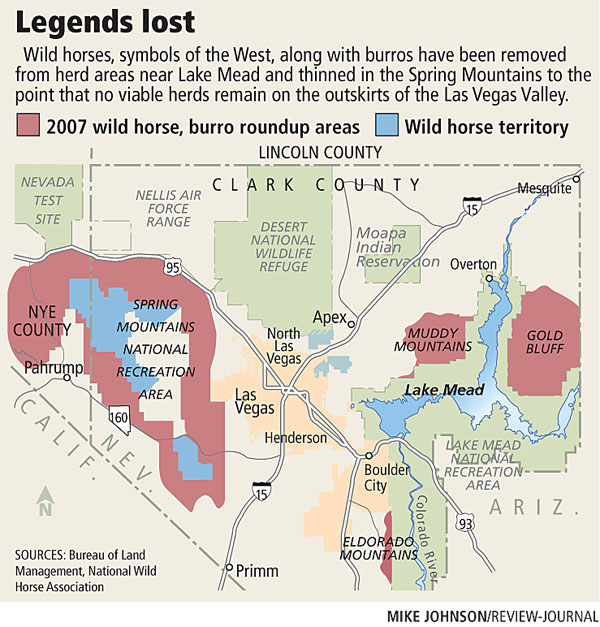Government urged to save wild horses
Wild horse advocates fear the free-roaming legends of the West might vanish from the ranges within five years if the federal government continues to round them up, as they've done in Red Rock Canyon.
At a news conference Monday, they said they will petition Congress to force several federal agencies to stop most roundups and return horses now in some holding facilities to historic ranges.
They also don't want "excess" horses euthanized, as Bureau of Land Management officials have suggested might be necessary.
"How can we let our government destroy the last of what we have?" said Karen Sussman, president of the International Society for the Protection of Mustangs and Burros, wrapping up the weekend's Wild Horse and Burro Summit in Las Vegas.
Any hope for keeping viable herds in Clark County have already been quashed by emergency roundups by the Bureau of Land Management and U.S. Forest Service in recent years. No viable herds now exist near the Las Vegas Valley.
About 35 horses roam the south end of Red Rock Canyon, about a dozen are left on Mount Charleston, and no horses or burros are in the Muddy Mountains or Gold Butte, based on estimates by the National Wild Horse Association.
The BLM released only 17 back to the Red Rock range after a gather a few years ago, and some advocates believe the herd has fewer than 35 horses, perhaps as few as 21.
Even the largest herd in the Spring Mountains, which numbers about 125 near Cold Creek, is not enough to maintain a viable herd, said Shari Warren, vice president of the National Wild Horse Association.
The BLM has removed excess horses from six areas in the Spring Mountains and west of Lake Mead in helicopter-assisted gathers to prevent deterioration of habitat and to maintain a thriving, ecological balance for a multiple-use management concept. Advocates believe if the horses' gene pool is not diverse enough, birth defects and health problems will result.
"You used to do the loop in Red Rock, and you'd see horses. You can't anymore, but in Cold Creek you can still see them," Warren said.
Sussman, speaking to reporters at a corral near the Western Trails Equestrian Park, said it takes about 150 horses to maintain a genetically viable herd and 75 percent of the nation's herds have fewer than that.
She said the herds are rapidly declining and many will be zeroed out in five years, even though BLM officials disagree.
"I think that's an erroneous statement," said Doran Sanchez, communications chief for the BLM in Nevada.
Barbara Wolin, a Las Vegas wild horse enthusiast who was one of about 75 summit participants, said the BLM should put horses back in herd areas that are being used for ranching and other interests.
"I just want to see the horses handled properly and given their just due. They need their place on the range," she said.
"I don't think they've made the effort to do what they need to bring some relief for these horses," Wolin said about the BLM.
Laurie Howard, who has served on the boards of a number of wild horse advocacy groups, brought her pinto mustang, Coco, to Monday's news event. She wants Congress to intervene so that wild horses won't be euthanized.
"We're only hoping that the BLM will listen to our suggestions," she said.
Howard said BLM Deputy Director Henri Bisson seemed to be leaning the way of advocates who called for a halt to the roundups and understood their concerns for wanting to return gelded horses to historic herd areas and pursue better birth-control methods for mares.
"He was very receptive to everything, but he's on his way out," Howard said, noting that Bisson plans to retire early next year.
"One of the things we're concerned about is that (BLM) wild horse specialists are trained properly and that the management is trained properly" and that they understand that family bonds among horses shouldn't be broken, Howard said.
Sanchez said even if there are gathers next year, the horses that are left have a 20 percent reproduction rate. In a few years there would be too many horses for the ranges to support, especially in Nevada, where wild fires have taken a toll on forage and water is scarce.
"It's imperative to maintain the overall health of the range and not only for wild horses and burros but also for permitted livestock and wildlife," he said in a telephone interview.
Sussman said the BLM's estimates of 29,500 wild horses in 10 Western states is off by as many as 15,000.
Sanchez said, however, the BLM's count is accurate.
In Nevada, the BLM estimates about 16,000 are in the state, mostly in central and Northern Nevada. Those in Southern Nevada represent 2.5 percent of the nation's wild horses.
Meanwhile, federal holding facilities are at capacity, adoption outlets are saturated and the BLM is considering exterminating those that are declared excess. The BLM's budget for wild horses is not expected to increase and bureau officials say they are left with no choice but euthanasia to curb holding costs.
Nearly 74,000 horses were taken off the nation's ranges between 2001 and 2007. Some 44,000 have been adopted, leaving about 30,000 in holding facilities.
"This is a force that has to be reckoned with," Sussman said about the BLM's roundup practices. "They have not been an agency we can rely on."
Contact reporter Keith Rogers at krogers@reviewjournal.com or 702-383-0308.
ON THE WEB Slideshow ADOPTION PLANNED The National Wild Horse Association and the Bureau of Land Management will have a wild horse and burro adoption Sunday at Horseman's Park, 5800 E. Flamingo Road. The animals, including a 3-year-old jack burro named Gummy Bear and Nash, a 2-year-old bay gelding, can be seen from 9 a.m. to 5 p.m. Saturday and from 9 a.m. ro 10 a.m. Sunday prior to the adoption. For more information, go to www.nwha.us or call 452-5853, or 515-5024.



















